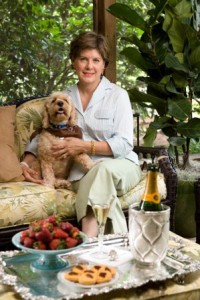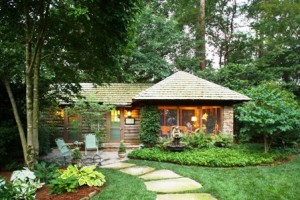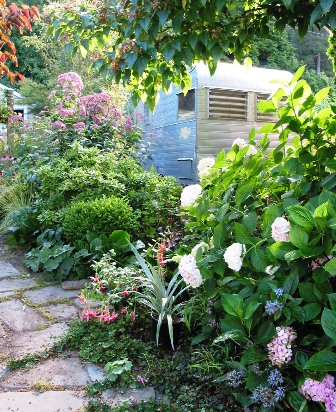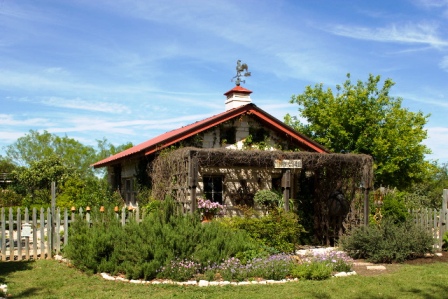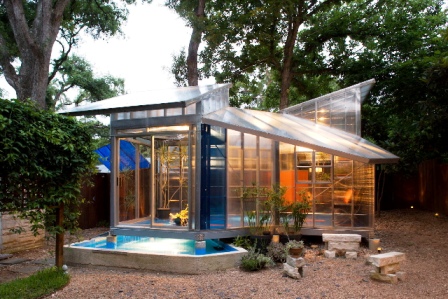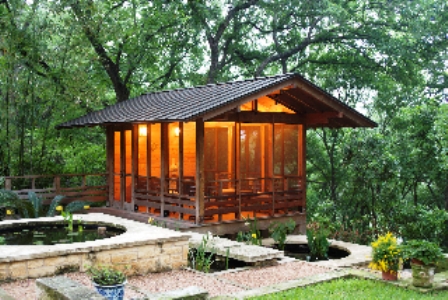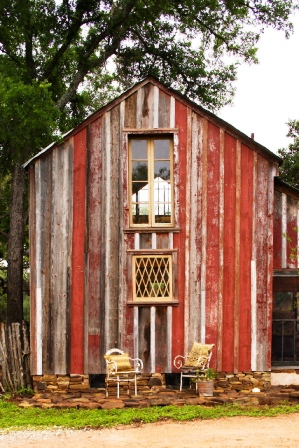 My friend Paula Panich recently shared this passage from Doris Lessing’s 2007 Nobel Prize for Literature speech, presented on December 7, 2007. Lessing urges writers (and, I would imagine, any creative person) to seek a distinct and personal space in which to feel surrounded and enveloped when putting pen to paper. Her admonitions gave me goosebumps. It was if this literary icon was speaking directly to me. There she was, an accomplished and celebrated author, sharing an insight about the practice, the craft, of writing. And what she says — about escaping to that separate place — feels just right. Read an excerpt below:
My friend Paula Panich recently shared this passage from Doris Lessing’s 2007 Nobel Prize for Literature speech, presented on December 7, 2007. Lessing urges writers (and, I would imagine, any creative person) to seek a distinct and personal space in which to feel surrounded and enveloped when putting pen to paper. Her admonitions gave me goosebumps. It was if this literary icon was speaking directly to me. There she was, an accomplished and celebrated author, sharing an insight about the practice, the craft, of writing. And what she says — about escaping to that separate place — feels just right. Read an excerpt below:
“Writers are often asked: “How do you write? With a [word] processor? an electric typewriter? a quill? longhand?” But the essential question is: “Have you found a space, that empty space, which should surround you when you write? Into that space, which is like a form of listening, of attention, will come the words, the words your characters will speak, ideas – inspiration.”
If this writer cannot find this space, then poems and stories may be stillborn.
When writers talk to each other, what they ask each other is always to do with this space, this other time. “Have you found it? Are you holding it fast?”
Let us now jump to an apparently very different scene. We are in London, one of the big cities. There is a new writer. We, cynically, enquire… “Is she good-looking?” If this is a man: “Charismatic? Handsome?” We joke, but it is not a joke.
This new find is acclaimed, possibly given a lot of money. The buzzing of paparazzi begins in their poor ears. They are feted, lauded, whisked about the world. Us old ones, who have seen it all, are sorry for this neophyte, who has no idea of what is really happening. He, she, is flattered, pleased. But ask in a year’s time what he or she is thinking. I’ve heard them: “This is the worst thing that could have happened to me.”
Some much-publicised new writers haven’t written again, or haven’t written what they wanted to, meant to.
And we, the old ones, want to whisper into those innocent ears: “Have you still got your space? Your soul, your own and necessary place where your own voices may speak to you, you alone, where you may dream. Oh, hold on to it, don’t let it go.”
For so long, I have had to apologize for wanting to close my office door. Yet having a door is a luxury, considering the place where I used to sit when I wrote. Before moving to my current home nearly a year-and-a-half ago (where my office is a former bedroom with a real door — hinges, knob and lock included), my writing desk resided in a corner of an open loft.
Yes, all three bedroom doors opened onto this space where desk, computer and bookcases were shoved against one wall. This space also contained a futon and a cabinet where the television was hidden. I began freelance writing in earnest when we built this home in 1998, with a one-year-old and a six-year-old nearby. As a writer, I shared this “sacred” space with the children’s play area (in those days, in the late 1990s, I would actually un-plug the phone and fax during nap-time, holding my breath that the UPS delivery guy wouldn’t ring the doorbell and destroy my perfect 90 minutes of quiet!).

My daily view, Lake Washington (1998-2006)
In one sense, I couldn’t complain, because this perch offered me the most dazzling views of second-growth Northwest forest (on a park-peninsula that jutted into Lake Washington), the lake’s ever-changing, but usually grey-blue surface, and the top peaks of the Cascade mountains to the east. How could I whine about my work space when I enjoyed the respite of lifting my eyes away from the computer screen to peer at this gift of nature anytime I needed a pause?
Yet, to use a phrase that novelist Amy Bloom shared with me about her “mom” years as a writer: I was interruptible. Can you imagine being on deadline for an article while also listening to Pokemon cartoons playing in the background? Or trying to conduct a telephone interview while whispering an answer to the daily question: Mom, what can I have to eat? Moms who are attempting to create anything — art, words, a garden — can imagine this.
So yes, I jealously guard my current office with a DOOR THAT CLOSES. I get testy whenever someone enters. There is a comfy futon in here, too, so I occasionally feel like a talk-show host who entertains a steady stream of guest stars…this is usually when one of my guys plops down on those welcoming lime green cushions and wants to talk. But sometimes . . . I just want to lock the door and relish in solitude and the creative atmosphere it produces.
 The pursuit of personal, hidden, secluded space for one’s creative endeavors is a thread that runs through my forthcoming book, Stylish Sheds and Elegant Hideaways. While interviewing and photographing locations with my partner Bill Wright, I was so often struck with a sense of awe that the many gifted and talented individuals we profiled trusted us enough to share their “necessary place” with us. They knew we gave respectful attention to their studios, ateliers, nooks and sheds. Regardless of the artistic endeavors that may occur inside the owner’s tiny structure, often measuring just a few hundred square feet in size, we were well aware of the honor and prestige bestowed upon each space. For those whose professional pursuits seem mainstream or decidedly non-artistic, the private, personal space is somehow even more precious: a symbol of time to daydream, ponder and contemplate; to be alone with oneself.
The pursuit of personal, hidden, secluded space for one’s creative endeavors is a thread that runs through my forthcoming book, Stylish Sheds and Elegant Hideaways. While interviewing and photographing locations with my partner Bill Wright, I was so often struck with a sense of awe that the many gifted and talented individuals we profiled trusted us enough to share their “necessary place” with us. They knew we gave respectful attention to their studios, ateliers, nooks and sheds. Regardless of the artistic endeavors that may occur inside the owner’s tiny structure, often measuring just a few hundred square feet in size, we were well aware of the honor and prestige bestowed upon each space. For those whose professional pursuits seem mainstream or decidedly non-artistic, the private, personal space is somehow even more precious: a symbol of time to daydream, ponder and contemplate; to be alone with oneself.
Here are some of the comments we gathered during our interview and photography sessions:
“The real reason my shed exists is so that I can work uninterrupted. There is no phone, no Internet in here.” — Amy Bloom, novelist and creator of Lifetime Network’s ‘State of Mind’
 “In designing this studio, my motive was to make it a happy space, because I make happy art.” — Liz Lyons Friedman, printmaker
“In designing this studio, my motive was to make it a happy space, because I make happy art.” — Liz Lyons Friedman, printmaker
“Being in the shed makes me feel more connected – and grounded – to the creative forces that simplicity affords. It’s a very practical environment that offers a great escape from all the complexities that surround me.” — Lin Su, designer and painter
“Here’s where I keep everything I want to save and love. This is my little comfort zone, my quiet place.” — Sunni Rudd, illustrator
Another quote from Sunni: “I have a hard time slowing down, but when I come here I want the solitude of my garden shed. It keeps me on an even keel. It keeps me planted.”
“I always wanted to find a place in the country – a retreat. And for years, I had plans for this potting shed in my mind.” — Sylvia Williams, Master Gardener
“People don’t necessarily need more house as much as they need more places to be where they can have fun and utilize their outdoor spaces.” — Kathy Fries, horticulturist
“If I’m inside my shed and it’s raining outside, I feel cozy. On warm days, I pull my chair out to the shed, open the windows and doors, and enjoy the view of my garden.” —Joan Enticknap, banking executive and avid gardener
“It’s so beautiful to be in the little house. We use it in the evenings, on Sunday afternoon when the sun pours in, in the fall when we have a fire going and the doors are open. It’s heaven.” — Anne Kennedy, artists’ agent
 “The moment I enter, I’m in a different world.” — Rand Babcock, furniture designer
“The moment I enter, I’m in a different world.” — Rand Babcock, furniture designer
“It’s intimate; it’s a space that transforms your mood when you enter.” — Tony Nahra, furniture designer
“It’s a lovely place for me to get away. I like to go up there and view the garden; there’s always a nice breeze and I’m away from the phone!” — Patrick Anderson, plant collector and musician
“We’re perfectly aware that we have things to do indoors, but it’s hard to stop being there.” — Beverly Sutton, pediatrician and child psychiatrist
The “space” to which Doris Lessing refers may be a physical space, like a writing studio, sacred and separate. Or, perhaps it is an inner space, the hard-to-explain silence we seek when beginning a writing project. But it is vital and valid, and necessary.
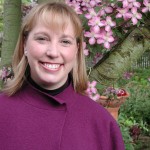 I think many of us have experienced that frequent voice whispering in our ear, offering words of wisdom, advice, encouragement and humor — just when we need them. For me, and for many of her beloved friends, that voice belongs to Linda Plato. “It’s all good,” was one of her favorite sayings. Or, her shorthand version of that phrase: “Good times.”
I think many of us have experienced that frequent voice whispering in our ear, offering words of wisdom, advice, encouragement and humor — just when we need them. For me, and for many of her beloved friends, that voice belongs to Linda Plato. “It’s all good,” was one of her favorite sayings. Or, her shorthand version of that phrase: “Good times.”








